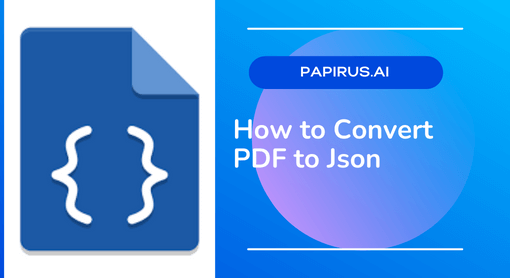
How To Convert PDF to Json
Many companies and organizations store their documents, files and information in a digital format. However, sometimes they need to convert the PDF file to JSON data for many reasons including accuracy and more efficient storage.
What is a PDF File?
A PDF file is a Portable Document Format file. PDF files are generally created by Adobe Acrobat software. PDF files can also be viewed with web browsers such as Firefox, Google Chrome, Microsoft Edge, and Safari. They can contain text, images, and hyperlinks.
Why and How to Convert a PDF to Json Data?
PDF, or Portable Document Format, is a file format that allows for easy sharing of documents across platforms. While PDFs are great for document sharing, they’re not so great when it comes to data analysis. That’s where JSON, or JavaScript Object Notation, comes in.
JSON is a lightweight data-interchange format that’s perfect for storing and manipulating data. Unlike PDFs, JSON files can be easily parsed and analyzed by computers.
So, if you need to convert a PDF to JSON data, how do you do it?
There are a few different ways to convert a PDF to JSON data. One way is to use a online converter tool, like PDF2JSON. Another way is to use a programming language like Python with the help of a library like pdf2json. Finally, you could also use Papirus AI like Adobe Acrobat Pro DC which has built-in functionality for converting PDFs to JSON data.
No matter which method you choose, converting your PDFs to JSON data will make it easier to work with your data and get the insights you need.
The Difference Between JSON and CSV Data Formats
When it comes to data formats, there are two main contenders: JSON and CSV. So, what’s the difference between JSON and CSV data formats?
Well, for starters, JSON is a lot more flexible than CSV. JSON allows for nested data, which means you can have multiple layers of data within a single file. CSV, on the other hand, is much more simplistic. It’s effectively just a list of values separated by commas.
Another key difference is that JSON supports multiple data types (strings, numbers, Booleans, etc.), while CSV is limited to just strings. This means that if you have any non-string data in your file (like dates or times), you’ll need to convert it to a string before you can save it as a CSV.
Finally, JSON files are typically smaller than CSV files. Because they’re more concise. They don’t require any extra punctuation (like commas). This can be helpful if you’re working with large datasets.
Overall, both JSON and CSV have their own advantages and disadvantages. It really depends on your specific needs as to which format will work better for you.
How To Convert PDF to JSON?
If you have PDF files that you want to convert to JSON data, there are a few easy steps you can follow to get the job done. First, you will need to upload your PDF files to a online PDF to JSON converter. Once you have done that, simply select the file or files you wish to convert. Then click on the “Convert” button. The conversion process will start automatically and once it is finished, you can download the converted JSON file or files to your computer.
Conclusion
There are a number of reasons why you would want to convert PDF to JSON data. Perhaps you need to interface with some legacy software that only accepts JSON input. Maybe you’re building a web application that will be used by people all over the world. You need to ensure that your data is in a format that can be easily consumed by everyone. Whatever your reason, there are a few different ways to go about converting PDF to JSON data. Pick the method that best suits your needs and give it a try. You might be surprised at just how easy it is to get started with JSON.
For your all convert pdf to json needs contact us. Papirus AI will increase your efficiency.